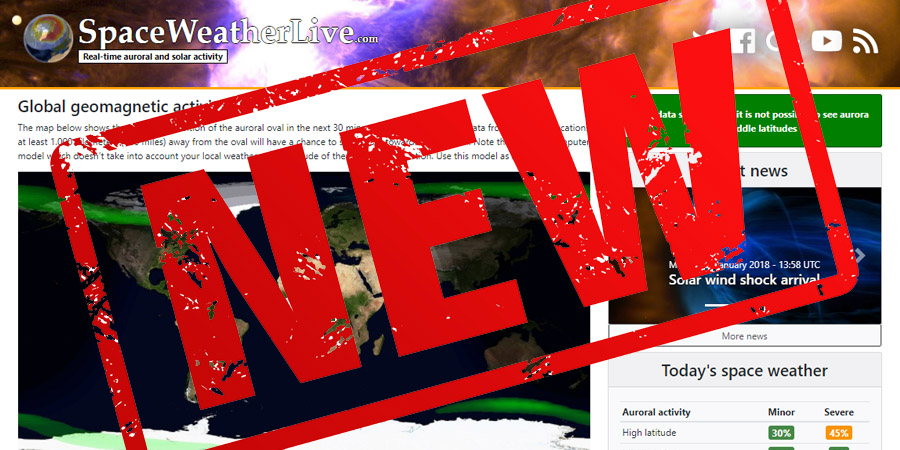New and improved site
Saturday, 20 January 2018 14:17 UTC

SpaceWeatherLive is proud to present a brand new version of the website! For the last few months we’ve been very hard at work behind the scenes rewriting (literally) all of the pages to improve the whole website in many ways. Together with all the improvements in speed, code and a bunch of other stuff we also introduced a modernised look and feel for the whole site.
Apart from a lot of tinkering under the hood and the modernized overall layout, we also made some other changes which we hope you will enjoy:
Like we did on Twitter and the push alerts some time ago, we have dropped the Wing Kp alert bar on the website. You know the one which could say that current Kp is 5 but the expected Kp is 8+ or something wild like that. We found this too confusing and just not reliable creating false expectations for you, the end user. We replaced these Wing Kp alerts with a single alert bar just stating the latest observed Kp (if the Kp is 4 or higher) coming from the NOAA SWPC and at what time the threshold was reached. This alert bar stays for a maximum of 3 hours following the time the threshold was reached. If the NOAA SWPC issued a new Kp-alert before these three hours are over, the alert bar will be replaced with the new value. Simple and much more reliable.
Another new site alert has been introduced for coronal holes. These alerts are a fan favorite on our Twitter page and have been there for a long time but now we also manage to issue the alerts on our website. When a coronal hole faces Earth, an alert bar will pop up in the top right corner stating when the coronal hole was detected and what kind of coronal hole it is: southern hemisphere, northern hemisphere etc... This alert bar stays for 24 hours after a detection and the detection system is 100% automated.
Our new coronal hole page is also finished and can be found under the solar activity menu. The previously mentioned alert will also be issued on that page but stay there for 3 days.
There’s a lot more to discover, we have made lots of small and bigger changes everywhere so browse around to discover them! We still have some more ideas that we’re working on that require some more time and testing but that’s for future updates. As with all major updates, stuff can go wrong. If something is broke or isn’t displayed like it should, please let us know in the comments!
We are proud to say that SpaceWeatherLive is now available in eight languages, thanks to the hard work of volunteers all over the world that provided the translations and keep answering our emails whenever we need the languages to be updated. You guys rock!
Under the hood we made it even easier to translate our website and to maintain it. If you like to help out in improving a language or you want to provide a whole new language, contact us and we’ll get you going.
To make our website ready for the future, we had to make some sacrifices like dropping support for ancient browsers (like IE8+9 and iOS<7).
Thank you for reading this article! Did you have any trouble with the technical terms used in this article? Our help section is the place to be where you can find in-depth articles, a FAQ and a list with common abbreviations. Still puzzled? Just post on our forum where we will help you the best we can!
Latest news
Latest forum messages
Support SpaceWeatherLive.com!
A lot of people come to SpaceWeatherLive to follow the Sun's activity or if there is aurora to be seen, but with more traffic comes higher server costs. Consider a donation if you enjoy SpaceWeatherLive so we can keep the website online!

Space weather facts
| Last X-flare | 2024/03/28 | X1.1 |
| Last M-flare | 2024/04/18 | M2.2 |
| Last geomagnetic storm | 2024/04/16 | Kp5 (G1) |
| Spotless days | |
|---|---|
| Last spotless day | 2022/06/08 |
| Monthly mean Sunspot Number | |
|---|---|
| March 2024 | 104.9 -19.8 |


